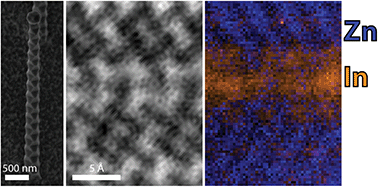Heterotwin Zn3P2 superlattice nanowires: the role of indium insertion in the superlattice formation mechanism and their optical properties†
Abstract
Zinc phosphide (Zn3P2) nanowires constitute prospective building blocks for next generation solar cells due to the combination of suitable optoelectronic properties and an abundance of the constituting elements in the Earth's crust. The generation of periodic superstructures along the nanowire axis could provide an additional mechanism to tune their functional properties. Here we present the vapour–liquid–solid growth of zinc phosphide superlattices driven by periodic heterotwins. This uncommon planar defect involves the exchange of Zn by In at the twinning boundary. We find that the zigzag superlattice formation is driven by reduction of the total surface energy of the liquid droplet. The chemical variation across the heterotwin does not affect the homogeneity of the optical properties, as measured by cathodoluminescence. The basic understanding provided here brings new propsects on the use of II–V semiconductors in nanowire technology.



 Please wait while we load your content...
Please wait while we load your content...